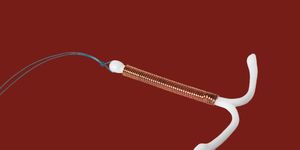
When it comes to birth control it doesn’t get any simpler than the ParaGard.
Once the tiny, copper-coated IUD is inserted into your uterus, your job is done (unless you want to check the strings every once in a while)—and it stays that way for up to 10 years.
It’s easily reversible, inexpensive, and highly effective (99 percent, to be exact—higher than the Pill’s 95 percent, according to the ParaGard website). It’s also totally hormone-free (it’s made of copper, which causes an inflammatory response in your body to keep sperm out of your uterus), which means it’s a safe, easily tolerated option for people who can’t take other types of birth control.
Honestly, it sounds like a freaking dream…but keep in mind, this is still an object being inserted into your body for medical purposes, which means it doesn’t come without a few (unpleasant) side effects. Here are a few you should watch out for on ParaGard.
1. You have longer, heavier periods.
The most common side effect of the ParaGard IUD (and the one that women report bothers them the most) is that it often increases the length and amount of menstrual bleeding, says Elizabeth Reynoso, M.D., an ob-gyn at MomDoc Women For Women in Arizona.
In fact, the majority—over two-thirds—of women complained of heavier bleeding during the first year of using ParaGard, according to a 2010 study published in the journal Contraception.

If you have a light-to-normal cycle to begin with, you may just have to upgrade your tampon size but if you have a history of excessive bleeding then this IUD might be kind of a nightmare. If you are looking to lighten or control your bleeding instead, talk to your doctor about a hormonal form of birth control, like the Mirena IUD, she says.
2. You see spotting all the time.
Increased bleeding due to the ParaGard isn’t only a concern during your period—the IUD can also increase spotting at any point during your cycle, Reynoso says.
The inflammatory response created by your body’s reaction to the copper increases the rate at which your uterus sheds its lining. For some women, it’s small enough that this is simply seen as a nuisance and they adjust to it over time while others feel like their period just never stops.
3. You smell something fishy down there.
Though rare, all IUDs, including the ParaGard, up your risk for bacterial vaginosis (BV), an infection characterized by a “fishy” or bad smell, says Richard K. Krauss, M.D., chair of the gynecology department at Aria Health.

BV also comes with discolored discharge and pelvic pain. These symptoms warrant a call to your doc ASAP before the infection spreads—left untreated, it can lead to pelvic inflammatory disorder (PID), which can impact fertility. Luckily, treatment is easy: the infection can be treated with a course of antibiotics, says Krauss.
4. Your cramps are crazy-bad.
Cramps are a standard period side effect—you are, after all, sloughing off chunks of your uterine lining—but they can become more intense and last longer with the ParaGard.
Up to 15 percent of women reported debilitating pain when using it, according to the same Contraception study. In addition, it’s very common to experience painful cramps during the insertion process and in the month following, Ross says.
5. You’re feeling weak and lightheaded.
Heavy menstruation sometimes comes with its own special side effect: anemia.
Basically, the more you bleed, the more iron you lose; and if you lose enough iron, the levels in your blood won’t be sufficient, leading to symptoms like fatigue, pale skin, weakness, lightheadedness, constantly feeling cold, and chest pain, Reynoso says. Make sure you mention any unusual symptoms to your doctor, and if you have heavy periods, ask to get your iron levels checked at your next exam.
6. You have flu-like symptoms…but you don’t have the flu.
Pelvic inflammatory disease (PID) is another type of infection that can be caused by the Paragard, Ross says, and shows up as flu-like symptoms—fever and chills—along with painful sex, severe cramping, weird discharge, or heavy bleeding, especially within one month of getting the ParaGard put in.

This one’s pretty rare, too, but it’s important to catch the infection early (it can be treated with antibiotics); left untreated, PID can permanently damage your reproductive system.
7. Your ParaGard IUD actually fell out in the toilet.
It’s not common, but it’s possible for the ParaGard to “migrate” to another part of your body or to fall out completely, according to the manufacturer’s site.
In both cases, you’re no longer protected against pregnancy, and should call your doctor immediately, using back-up birth control in the meantime.
Source: Read Full Article
